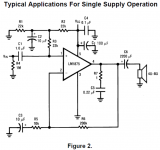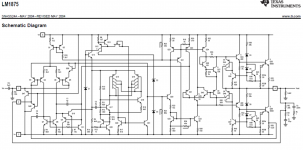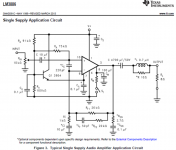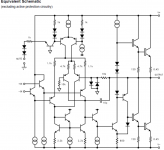The first "separates" system I ever bought, included a Spectro Acoustics stereo power amp with Quasi Complementary output stage and GIGANTIC turn-off thump. Yes, Nelson, I ran it into brand new ESS AMT-1 loudspeakers. Good times.
I know the sound of that thump. It starts at your ears but then gains momentum reverberating around in the depths of your soul for a while before finally exiting out in a gigantic bang through your wallet.
46 citations!? That’s more than your average American phd thesis these days. I guess it’s in part to justify the required trade of a universal blood type first born for one of those AP sets.
Fun fact: John Nash’s phd “Non-Cooperative Games” had only 2 citations, which I think may be the record holder.
https://rbsc.princeton.edu/sites/default/files/Non-Cooperative_Games_Nash.pdf
46 citations!? That’s more than your average American phd thesis these days.
I dunno, my Master's thesis (published 1982, 97 pages) had 48 citations. Frighteningly, they sent 2 copies to the director of DARPA and 6 copies to the director of the Naval Research Lab. Maybe it somehow got used to help build stealth submarines or something.
(link to scary website whose internet domain is .mil)
Hi Mark.I dunno, my Master's thesis (published 1982, 97 pages) had 48 citations. Frighteningly, they sent 2 copies to the director of DARPA and 6 copies to the director of the Naval Research Lab. Maybe it somehow got used to help build stealth submarines or something.
(link to scary website whose internet domain is .mil)
That link seems to lead to nowhere, do you have another link to your paper please ?.
Dan.
it works: http://www.dtic.mil/dtic/tr/fulltext/u2/a121539.pdf
I had 15 yrs then , thinking about ...... well , practically nothing except scent .... 🙂
I had 15 yrs then , thinking about ...... well , practically nothing except scent .... 🙂
I have designed a few cheapo amplifiers.
I modified an old Maplin lateral mosfet amplifier to work with vertical mosfets.
That worked very well.
I even designed an IGBT output transistor quasi amplifier and that sounded OK.
It unless I do something really stupid I find it hard to design a bad sounding amp.
I modified an old Maplin lateral mosfet amplifier to work with vertical mosfets.
That worked very well.
I even designed an IGBT output transistor quasi amplifier and that sounded OK.
It unless I do something really stupid I find it hard to design a bad sounding amp.
I dunno, my Master's thesis (published 1982, 97 pages) had 48 citations. Frighteningly, they sent 2 copies to the director of DARPA and 6 copies to the director of the Naval Research Lab. Maybe it somehow got used to help build stealth submarines or something.
Interesting work Mark.
There’s a pretty wide spread for thesis citations. I was being tongue-in-cheek and taking a slight jab at the current state of higher education.
Goofing aside, it seems the trend for citations is actually upward, which would indicate to me the lack of something very original to say.... or maybe just higher quality journal search engines, who knows.
Or it could just be that I read this the other day and am being pessimistic 😛
The Death of Expertise: The Campaign against Established Knowledge and Why it Matters https://www.amazon.com/dp/0190469412/ref=cm_sw_r_cp_api_pk8nBbH124YRW
An EE thesis typically includes introductory material, previous work, new research, measured data, conclusions, and suggestions for further study. The introductory section usually cites a large number of references, because you're bring the reader up-to-speed starting from the basics, and there are lots of basics to be covered. The thesis author also wants to quote and to cite the original sources, the most authoritative sources, the best sources, (not just the most convenient sources) for each important piece of background material or prior art. That's why you seldom see Wikipedia or Encyclopedia Britannica listed in the References section of a thesis; they are neither the original nor the best sources.
At least in 1982 when I wrote mine, the EEs at my university took Isaac Newton's saying to heart: "If I have seen further it is by standing on the shoulders of Giants." We meticulously detailed the work of our predecessors, taking care to give them all due credit and respect. And then showed how this carefully cited earlier work, became a launching pad for the brand new research discussed in the 2nd half of the thesis.
I just had a quick look at my office-mate's thesis (Sept 1983): 57 references. Typical & normal. Mine had 48.
At least in 1982 when I wrote mine, the EEs at my university took Isaac Newton's saying to heart: "If I have seen further it is by standing on the shoulders of Giants." We meticulously detailed the work of our predecessors, taking care to give them all due credit and respect. And then showed how this carefully cited earlier work, became a launching pad for the brand new research discussed in the 2nd half of the thesis.
I just had a quick look at my office-mate's thesis (Sept 1983): 57 references. Typical & normal. Mine had 48.
...
Has anyone ever considered a “bad” cheap amplifier diy project that could run off the same supply and have the same output as a given pass diy design for purposes of comparison?
...
Ok, LOVE craplifier!
You deserve an award
Funklifier, mufflelifier, whinelifier ... it's endless!
I'm not sure about crap ...
But an easy Otherifier would be an AB chip amp, single supply:

Gain can go down to 10 and the input could be padded for lower gains, spec at 25V, close to 30V for max.
So, lots of parts:

Makes it other to the Pass.
Many stages and AB, that pushes it outside even more.
An Otherifier.
If you need higher voltage, go with lm3886 (spec: 28V, max: 40V )


Cheers
Last edited:
I just had a quick look at my office-mate's thesis (Sept 1983): 57 references. Typical & normal. Mine had 48.
Average dissertation and thesis length, take two – R is my friend
The data is all there, sortable by field.
http://citeseerx.ist.psu.edu/viewdoc/download?doi=10.1.1.119.9129&rep=rep1&type=pdf
Avg of 250-300 in agriculture / botany
What about a Class B PP amp where you can adjust bias to turn into Class AB. Maybe also playing with amount of NFB. Maybe some have a lot of 2N 3055 and 2N 2955 in stock they don't use 🙂 …..in TO-3 housing…...to be real vintage. TO-3 mounted output transistors looked very good…...but the more modern housing is easier to mount.
The design I keep thinking of is the 70W Quasi complementary amp that appeared in Popular Electronics around 1968 (?) that was based on an RCA ap note. It used 40411 output transistors and those 40409 and 40410 TO-5 drivers with the attached heat sinks.
Ok, LOVE craplifier!
You deserve an award
Funklifier, mufflelifier, whinelifier ... it's endless!
Thanks! Glad to have you in my corner.
I'm not sure about crap ...
But an easy Otherifier would be an AB chip amp
I wish I was able to properly thank you. You are speaking with someone trained in analyzing human behavior and cultures not schematics. So, just be aware you are casting your pearls before swine [emoji14]
I’m slowly making my way through Van Valkenburgh’s late 50’s / early 60’s high school basic electronics volumes.... solid state is a ways out in future editions.
It’s frustrating, yet very rewarding and refreshing, to take on a field in which you feel hopelessly confused again.
Thanks also to everyone else who has suggested ideas. Would it be possible to review them and sort out what might be the most effective or complete solution for the goals?
It would be enjoyable to assemble the best ideas put forth here, put a pcb together and send out a few for beta testing / fun. I’d be happy to oversee getting a few made up and sent out, since I’m not very useful as a troubleshooter..... it would begin and end with conveying whether it turned on and did not set fire to itself.
Personally I think I’ve largely overrated my hearing abilities (and I am guessing I’m probably not alone, it’s basic human nature), so I hope the “badness” levels would be sufficiently high.
As an aside: I was reading about Bob Carver and his bet with stereophile (I think?) regarding transfer function. Is it possible to alter a transfer function in real-time?
Last edited:
As an aside: I was reading about Bob Carver and his bet with stereophile (I think?) regarding transfer function. Is it possible to alter a transfer function in real-time?
It's my opinion that Bob simply wore them out. In any case, it appears
that he altered the frequency response and damping factor with passive
components, which you should be able to do without too much difficulty
if you have some test equipment for an objective comparison.
Wow. Mine was a relative lightweight with only 30 or so (it was in Civil Engineering). But I did get to correlate my data by boring about ten 100 mm holes through a concrete bridge deck - much to the consternation of the local authorities...I just had a quick look at my office-mate's thesis (Sept 1983): 57 references. Typical & normal. Mine had 48.
That bet was vaguely what I had in mind in post 16. Anyhow, it's refreshing to see this line of thought on the forum; anti-tweaks, if you will. And with a name like ScheissenMaster, it has to be bad! 😀As an aside: I was reading about Bob Carver and his bet with stereophile (I think?) regarding transfer function. Is it possible to alter a transfer function in real-time?
The REALLY delightful BadSounds arise from non-textbook mistakes.
Forget Douglas Self and his fourteen sources of (textbook) distortion. You want errors that aren't just a little bit wrong, you want errors that are "so wrong they're not even WRONG" as my pal the microwave CMOS textbook author often says. Mistakes so egregious, so spectacular, that teachers are unable to anticipate them beforehand. Errors so boneheaded, that Bob Cordell and Jan Didden will need to slap you upside the head with a bone, before you recognize them.
Big Old Azzssszzsx BoHunker Rookie Mistakes. That's what you want.
For example you want an amplifier that PHASE INVERTS when it goes into clipping. Douglas Self can't help you there, Bob Cordell can't help you there, Jiri Dostal can't help you there. You gotta channel the raw ignorant enthusiasm of a first year Intern to get an amp that inverts phase when it clips. Luckily, diyAudio is filled with spectacularly brilliant experts who can tell you whether you have, or have not, successfully implemented "phase inversion while clipping". I hope you are able to invent a way to compensate these experts for their time and expertise.
Forget Douglas Self and his fourteen sources of (textbook) distortion. You want errors that aren't just a little bit wrong, you want errors that are "so wrong they're not even WRONG" as my pal the microwave CMOS textbook author often says. Mistakes so egregious, so spectacular, that teachers are unable to anticipate them beforehand. Errors so boneheaded, that Bob Cordell and Jan Didden will need to slap you upside the head with a bone, before you recognize them.
Big Old Azzssszzsx BoHunker Rookie Mistakes. That's what you want.
For example you want an amplifier that PHASE INVERTS when it goes into clipping. Douglas Self can't help you there, Bob Cordell can't help you there, Jiri Dostal can't help you there. You gotta channel the raw ignorant enthusiasm of a first year Intern to get an amp that inverts phase when it clips. Luckily, diyAudio is filled with spectacularly brilliant experts who can tell you whether you have, or have not, successfully implemented "phase inversion while clipping". I hope you are able to invent a way to compensate these experts for their time and expertise.
I’m simply making clear my level of comprehension. I’m not unmotivated, I’m just at quite a disadvantage to those who’ve spent decades toiling over scopes.
My original question was if it already existed or what it would contain if it didn’t.
I was not suggesting dangerous functionality or something completely beyond what might be attributes in a commercial amplifier. I would like to get a better handle on what I’m hearing or what is audible to me.
It would seem reasonable that if someone says “this is good” they can also point you to something that is bad, in order for one to evaluate differences- not just technically speaking, but practically speaking. In other words, it will provide a given utilitarian result where the other does not and this is what it will be.
I was not aware I was being uncouth. What are you suggesting I should offer in exchange for the ideas you’ve graciously provided?
How does free mental health evaluations for all thread participants sound?
PM me for details!*
* must have posted before June 30th, 2018, one per person, no controlled substances will be dispensed.
My original question was if it already existed or what it would contain if it didn’t.
I was not suggesting dangerous functionality or something completely beyond what might be attributes in a commercial amplifier. I would like to get a better handle on what I’m hearing or what is audible to me.
It would seem reasonable that if someone says “this is good” they can also point you to something that is bad, in order for one to evaluate differences- not just technically speaking, but practically speaking. In other words, it will provide a given utilitarian result where the other does not and this is what it will be.
I was not aware I was being uncouth. What are you suggesting I should offer in exchange for the ideas you’ve graciously provided?
How does free mental health evaluations for all thread participants sound?
PM me for details!*
* must have posted before June 30th, 2018, one per person, no controlled substances will be dispensed.
It's my opinion that Bob simply wore them out. In any case, it appears
that he altered the frequency response and damping factor with passive
components, which you should be able to do without too much difficulty
if you have some test equipment for an objective comparison.
I would consider it just as clever if that were the case.
When I first read the article it appeared to me like there may have been a slight of hand.... much like a street performer with the three cups.
Lots of distracting visual cues, lots of suggestive narrative, sowing self-doubt and confusion, isolating adversaries or playing them against one another, tiring everyone out....
Car salesmen excel in this department.
I am personally awful at it and often think it’s not the greatest of strong suits but it’s fascinating to watch.
- Status
- Not open for further replies.
- Home
- Amplifiers
- Pass Labs
- DIY Craplifier Project